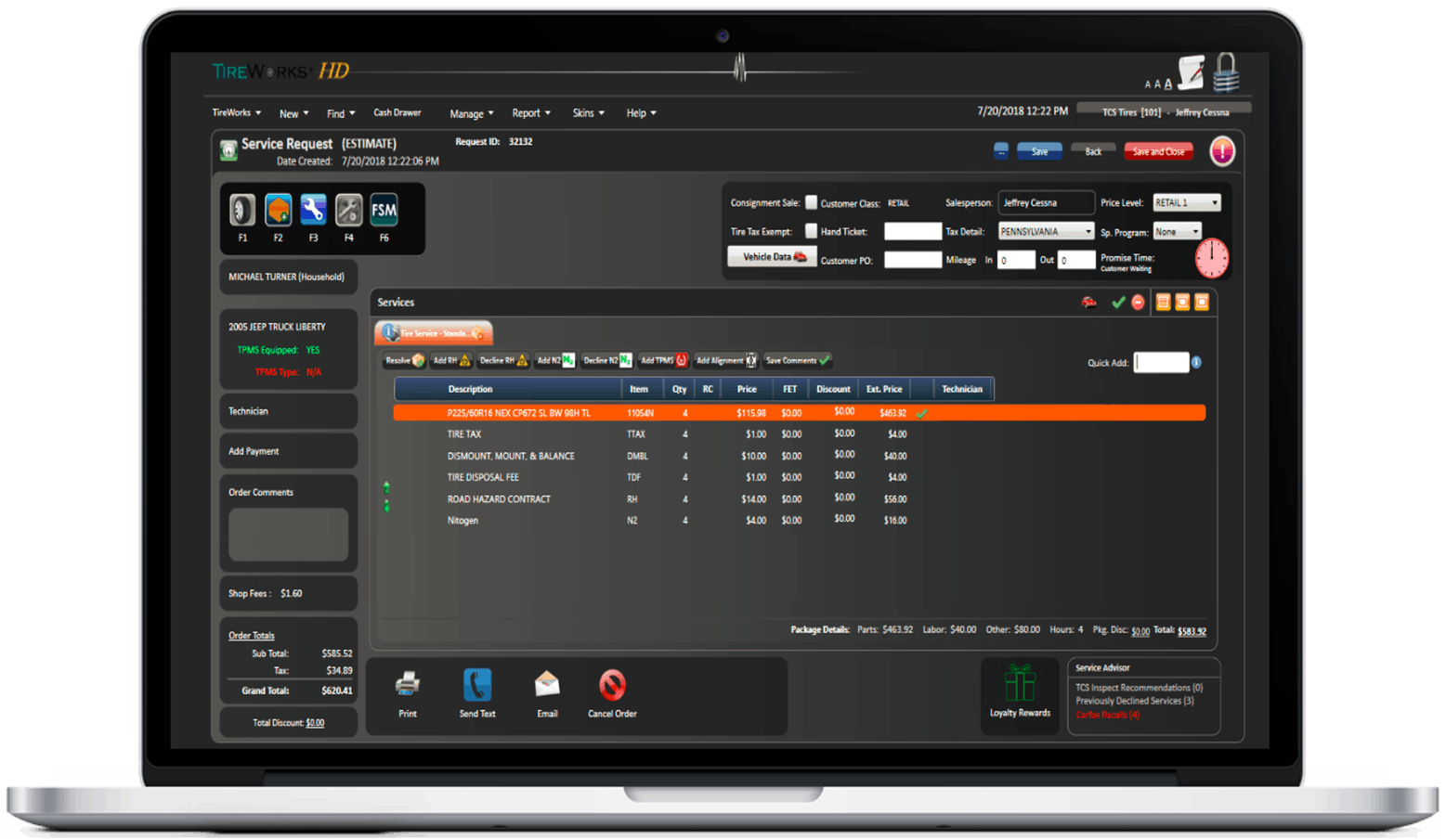When is the right time to invest in a new point-of-sale (POS) system? And once you make the investment, what tools might you and your team have at your fingertips, but for one reason or another aren’t utilizing?
The makers of five tire industry POS systems cover all the ways these tools can boost productivity and profitability and they share what the next wave of system capabilities will look like in 2025.
MTD: What’s the most common pain point tire dealers are trying to alleviate when they shop for a new POS system?
DAVID ANDREOLI, president, Andreoli & Associates Inc.: Some of the common pain points are inventory management issues, bad financials driven by lack of clear process and data collection in their existing system and lack of online selling capabilities (tire sales and scheduling appointments).
DEION DAVENPORT, director of revenue, ASA Automotive Systems Inc. (ASA): The most common pain point we hear from tire dealers is the need to simplify and streamline their daily processes. Many dealers struggle with inefficient workflows due to outdated systems or disconnected processes. Inventory is a prime example.
They need real-time visibility into what’s on hand, what’s on order and what’s available from their suppliers, but older systems often lack that seamless visibility.
Some dealers are still using pen-and-paper methods, which, while they’ve served the industry well in the past, now cost shops valuable time and create opportunities for errors. Others are using outdated software that doesn’t flow smoothly from one step to the next — slowing down everything from writing up a ticket to managing inventory to consumer communication. Today’s consumers expect text updates, online scheduling and digital approvals.
Dealers are looking for an all-in-one POS system that brings efficiency, better organization, and seamless communication across all areas of business.
STEPHEN YELVERTON, general manager, FreedomSoft: There are a few pain points we hear a lot from dealers. Many are frustrated with the usability of their current system. It’s not easy for their new employees to learn and it takes way too long to do basic tasks like quoting tires or selling from a customer’s history. The other pain point we’re hearing more and more is the decline in customer support from their current software company. Many have reached a breaking point and are looking for a change.
JAY ADAMS, president, MaddenCo Inc.: I don’t know that we see a most common pain point. Reasons for change vary wildly.
For some, it’s about moving away from an agnostic, off-the-shelf software to a true tire dealer software. For others, it’s about visibility into their suppliers’ inventories within the POS system (or) it’s mobile applications, whether for road service or for meeting people at their vehicle on premises. For some commercial dealers, it’s about having national account interfaces. Those are some of the reasons we see interest. There are many more.
JEFFERSON CARPENTER, director and general manager, TCS Technologies: First, we see a lot of dealers who feel like their POS is antiquated and holding their business back from meeting their customers’ expectations. As we all know, consumer expectations are advancing more rapidly than the tire industry and it’s important to find a forward-thinking software vendor who will grow and adapt to market changes. Secondly, at least half of the prospective dealers we talk to cite the support they are currently receiving as one of the reasons they are looking for a change. When shopping for software, be sure to ask for metrics around support response times, resolution times (and) customer satisfaction. Be sure to get some references, even if you ask your peers and find them on your own.
MTD: What report or tool within your POS system is overlooked or underused and why should tire dealers begin to utilize it?
ANDREOLI (Andreoli & Associates): One of the most underused features is the ability to lock (the option) to change selling prices at the counter. So often front counter sales reps “sell from their own wallet,” discounting pricing without ever being prompted by the customer. We typically see around a 5% or higher increase in sales when the dealer locks the ability for a sales rep to edit price.
The sales rep can still apply a discount, but this is trackable and they are held accountable for the price reductions they make.
DAVENPORT (ASA): Several valuable tools often get overlooked.
Appointment reminders. No-shows can hit 10% to 20% in some areas. A quick text reminder can drastically reduce missed appointments and keep bays full. Shops that implement this see higher customer retention and improved scheduling efficiency.
Reorder report. Set minimum/maximum inventory levels so the system tells you when to reorder. (This) helps shops stay stocked without overbuying (and) ensures that inventory is optimized without the guesswork.
ASApay payment processing. While not necessarily overlooked, ASApay is the new player in the field and more tire dealers are making the switch every day. With our latest release, shops can now process all payments in-house, eliminating third-party fees and reducing transaction costs. This gives dealers more control over their finances while increasing profitability.
Declined services report. (This is) one of the most underused tools with the highest revenue potential. Tracking and following up on declined services turns missed opportunities into future sales, boosts repeat business and strengthens customer trust.
These tools help increase efficiency, reduce costs and capture more revenue, all with minimal effort.
YELVERTON (FreedomSoft): One of the major benefits of using TireShop is speed. We’ve built in convenient, multi-tasking tools that allow you to jump from one area of the software to another without closing what you’re working on. It’s insanely fast. For instance, let’s say you’re building a new repair order for a customer and someone calls you on the phone to schedule an appointment.
Rather than backing out of what you’re already working on, simply press our multi-tasking shortcut and jump right to the appointment schedule. When you’re finished creating the appointment, back out and you’re right where you started — working on the original repair order you started. It’s really simple. While most of our customers utilize this and love it, some don’t and they’re missing out.
ADAMS (MaddenCo): Bar code scanning. The time savings when performing physical inventory is enormous.
CARPENTER (TCS Technologies): One of the most powerful tools that we have seen overlooked or underused is called the TireWorks HD Advisor. We essentially aggregate all the historical information about the vehicle from the CarFax Report, recommendations from digital inspections, services with scheduled intervals that have lapsed, as well as previously declined services, and pop them up on an actionable screen when the consumer drops off the car. Many POS systems have this information, but the user would need to go through the customer’s history and search for it.
MTD: How does a single-store tire dealership know when it’s time to invest in a new POS system? How should they think about their return on investment (ROI)?
ANDREOLI (Andreoli & Associates): Most dealers will put up with a bad system for longer than they should. When they come to realize they are losing a substantial amount of money due to lack of functionality or they feel their system is negatively impacting their customer’s experience in their shop, it is time to seriously consider a change.
DAVENPORT (ASA): There’s no universal perfect time to upgrade, but many dealers say they knew it was time when they moved from a home garage to a formal shop. That’s often when processes get too complex for manual systems. Some dealers feel the need before they officially decide. If you’re spending too much time double-checking inventory or if you’re re-entering the same data in multiple places, that’s a clear sign your current POS is holding you back. Another red flag is seeing competitors offering online scheduling, text updates or digital inspections, while your system can’t keep up.
When it comes to ROI, it’s not just about dollars spent — it’s about saving time, improving accuracy and increasing car count. A good POS speeds up processes (and) helps you order smarter, manage inventory accurately and keep up with pricing changes. This leads to fewer mistakes, faster service and happier customers. The best way to calculate return on investment is to see an increase in the number of cars exiting the shop daily and a higher average invoice total. Increased car count equates to more revenue, which is a clear sign of a good investment.
Systems that support text updates, online booking and digital inspections also help attract and retain more customers. And with better reporting tools, you can see which jobs make money and where you’re losing, so you’re basing decisions on data, not guesswork.
If your current system is slowing you down more than helping you grow, that’s your sign to upgrade. A modern POS isn’t just an expense — it’s an investment in efficiency, profitability and future growth.
YELVERTON (FreedomSoft): Every shop is different, but we’ve seen many that knew it was time for a change when they saw their peers’ satisfaction with software that is easy to use, offers great customer support and increases shop efficiency. A good POS/SMS is a financial investment in your business and the immediate and long-term returns are huge.
Many TireShop customers say it’s the single best thing they’ve done for their business’ efficiency, customer satisfaction and shop profitability.
ADAMS (MaddenCo): Oftentimes, this decision revolves around inventory management. A growing, one-store tire dealer either needs software that can properly track inventory or if the dealer is not keeping much inventory on hand, then the dealer will need connections to its suppliers’ inventories. One way to do that is to have multiple browser windows open and try to navigate purchasing that is not connected to the POS system. The better approach is to have that capability within the POS system.
CARPENTER (TCS Technologies): Most of the industry perceives POS software as an operational overhead that they just need to use. We think this is the question dealers need to ask themselves: “How much has this tool increased my revenue and my efficiency?”
If they struggle to come up with strong numbers and examples, it’s probably time for a change. ROI should be the biggest driving factor for your change. We have customers that have attributed a 9% growth in their business by making the change to TireWorks HD. If you’re making a decision based on the cost of the software, you’re focusing on the wrong thing.
MTD: What new capabilities are you rolling out in 2025?
ANDREOLI (Andreoli & Associates): HITS is releasing a native digital inspection and customer check-in app in the second quarter.
DAVENPORT (ASA): ASApay is our flagship feature launch for the end of 2024 and into 2025, with plans to seamlessly integrate it across all ASA products. ASApay offers simple installation, an intuitive user experience and is designed to reduce operational costs while making payment processing easier for dealers.
From a B2B perspective, we’re introducing an online portal that gives business accounts direct access to their invoices, statements and account history with their dealer. In early-2025, we’ll roll out integrated payment processing within the portal, allowing businesses to pay invoices directly online. This paperless process enhances convenience for customers, while helping dealers streamline receivables and improve cash flow.
On the operational side, our integrated Digital Vehicle Inspection (DVI) tool allows dealers to customize inspections. Dealers can attach photos and videos, giving customers a clear, visual understanding of their vehicle’s condition. Completed inspection reports are shared directly with customers. All inspection data flows directly into the POS, where dealers can track recommended services — including declined services — for better follow-up and future marketing efforts. We’ve partnered with an industry-leading DVI provider, ensuring our customers have access to the best, fully integrated inspection solution available.
YELVERTON (FreedomSoft): We’re constantly developing new capabilities in TireShop and working with new integration partners. We’ve recently added our own B2B websites for TireShop users who do some wholesale and want to sell online and now we’re finishing up an integration with TireConnect that will allow our customers to sell tires on their retail websites and push those new orders right into TireShop. Also while we’ve had an integration with Epicor ISE for many years (for parts ordering and labor), we’re introducing our own custom interface built directly into TireShop that allows for quicker part and labor searches. The new interface will also allow TireShop to display local inventory right in the Epicor search results. We’re beefing up our integration with AutoFlow and PartTech and much more.
ADAMS (MaddenCo): We are in the midst of building an outside purchase management system that will be an unbelievable time saver and enhancement for our customers. Managing non-inventory purchases is a huge burden for many dealers and this new system is going to make it much easier to do. We also have new mobile apps coming out that are beneficial to dealers across all industry segments.
CARPENTER (TCS Technologies): (New capabilities include):
- Bridgestone Firestone Treadnet integration (retail). Submit 17 types of delivery receipts without leaving the software; fleet and dealer lookups; data capture, verification and more.
- Bridgestone Firestone inventory lookup and ordering (retail). Inventory availability and pricing within all F1 Tire Search windows; one-click direct ordering and more.
- TireGuide integration (retail). Tailored workflows for tire-centric dealers; eliminates the overhead of a service catalog.
- AMI integration (retail). Adds the options for retail dealers to accept orders and return requests via AMI web.
- Enhanced RT integration (wholesale). Two-way integration enhances the RT Locator Warehouse Management System.
- QuickBooks Online (retail and wholesale). Two-way sync of data between TireWorks HD and QuickBooks Online; eliminates single-user mode with setup options to sync the data you want.
- Text-to-Pay and Authorize (retail). For dealers using 1stMile for credit card processing, customers can view and authorize work orders and also pay from their mobile device.
About the Author
Joy Kopcha
Managing Editor
Joy Kopcha joined Modern Tire Dealer and Auto Service Professional as senior editor in 2014 after working as a newspaper reporter for a dozen years in Kansas, Indiana and Pennsylvania. She was named managing editor of MTD and ASP in 2022, and took on that same role with Motor Age in 2024.
She is an award-winning journalist, including in 2023 when she was named a Jesse H. Neal Awards Finalist.
Don't miss any of her articles. Sign up for MTD's newsletters.



